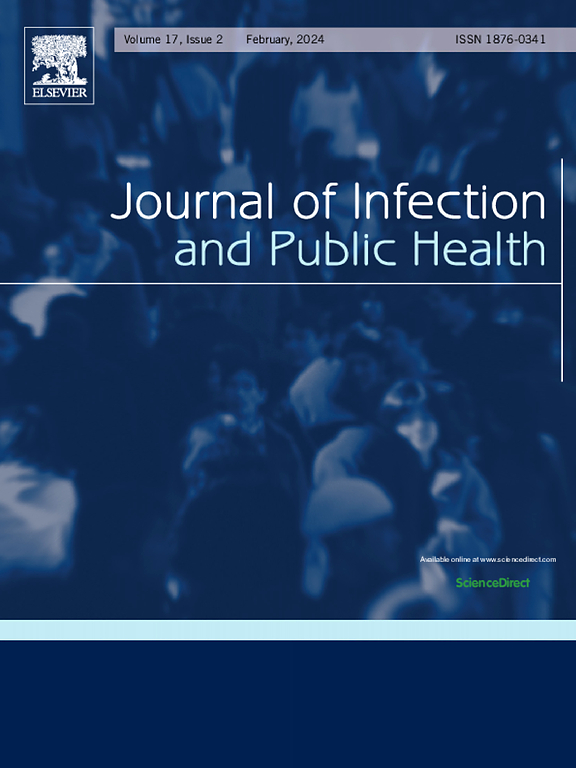1990年至2021年北非和中东区域六个常见性传播感染群体的负担:全球疾病负担的系统分析
IF 4.7
3区 医学
Q1 INFECTIOUS DISEASES
引用次数: 0
摘要
性传播感染(sti)是世界范围内最广泛的急性感染之一。北非和中东地区的性传播感染负担具有其独特的特点,迄今尚未得到彻底调查。在这项研究中,我们的目的是提供一个评估性传播感染的负担在NAME地区。方法分析GBD 2021研究的数据,评估包括发病率、患病率、死亡率和残疾调整生命年(DALYs)在内的健康指标。年龄标准化率(asr)和总数在21个NAME国家进行了评估,并按性别、年龄和社会人口指数(SDI)进行了细分。结果报告与95 %不确定区间(95 % UIs)。结果1990-2021年,性传播感染发病率由2670万例(95 % UI: 22.5 ~ 3150 万)上升至5580万例(4680 ~ 6740 万),而ASR发病率下降了5.4 %(-6.9 ~ - 4.2)。在患病率方面也观察到同样的模式。sti DALYs从412,021.2(160,004.8到824,494.5)下降到330,050.9(161,900.6到611,903.2),DALYs ASR下降了33.9 %(-48.1到- 18.5)。2021年,yll的数量是yld数量的3.7倍。性传播感染主要影响育龄人群,其中梅毒死亡率最高,生殖器疱疹患病率最高。女性比男性受影响更大。较低的SDI与较高的性传播感染负担相关。结论NAME地区STI负担反映了全球趋势,但考虑到社会规范,可能存在被低估的情况。筛查不足、认识不足、污名化以及获得医疗保健的机会有限加剧了该地区性传播感染的负担,特别是对妇女而言。性传播感染加剧了NAME人口增长的下降,特别是在SDI较低的国家。减轻NAME地区的性传播感染负担需要采取具有文化敏感性的方法、强有力的监测、教育、去污名化和改善医疗服务可及性。本文章由计算机程序翻译,如有差异,请以英文原文为准。
Burden of six common sexually transmitted infections groups in North Africa and Middle East Region from 1990 to 2021: A systematic analysis of global burden of diseases
Background
Sexually transmitted infections (STIs) are among the most widespread acute infections worldwide. The burden of STIs in North Africa and the Middle East (NAME) region, with its unique characteristics, has not been thoroughly investigated to date. In this study, we aim to provide an assessment of the burden of STIs in the NAME region.
Methods
Data from the GBD 2021 study were analyzed to assess health metrics including incidence, prevalence, mortality, and disability-adjusted life years (DALYs). Both age-standardized rates (ASRs) and total numbers were evaluated across 21 NAME countries, with breakdowns by sex, age, and sociodemographic index (SDI). Findings were reported along with 95 % uncertainty intervals (95 % UIs).
Results
From 1990–2021, the incidence of STIs increased from 26.7 million (95 % UI: 22.5–31.5 million) to 55.8 million (46.8–67.4 million), but the incidence ASR decreased by 5.4 % (-6.9 to −4.2). Same pattern was observed for prevalence. STIs DALYs decreased from 412,021.2 (160,004.8 to 824,494.5) to 330,050.9 (161,900.6 to 611,903.2), and DALYs ASR decreased by 33.9 % (-48.1 to −18.5). In 2021, the number of YLLs was 3.7 times the number of YLDs. STIs mostly affected reproductive age groups, with syphilis having the highest mortality and genital herpes the highest prevalence. Women were affected more than males. Lower SDI was associated with higher burden of STIs.
Conclusion
The NAME region's STI burden reflect global trends, but considering social norms, underestimation is probable. Inadequate screening, low awareness, stigma, and limited access to healthcare exacerbate STIs' burden in the region, particularly for women. Declining population growth in NAME is worsened by STIs, especially in countries with lower SDI. Reducing the STI burden in NAME requires culturally sensitive approaches, robust surveillance, education, destigmatization, and improved healthcare access.
求助全文
通过发布文献求助,成功后即可免费获取论文全文。
去求助
来源期刊

Journal of Infection and Public Health
PUBLIC, ENVIRONMENTAL & OCCUPATIONAL HEALTH -INFECTIOUS DISEASES
CiteScore
13.10
自引率
1.50%
发文量
203
审稿时长
96 days
期刊介绍:
The Journal of Infection and Public Health, first official journal of the Saudi Arabian Ministry of National Guard Health Affairs, King Saud Bin Abdulaziz University for Health Sciences and the Saudi Association for Public Health, aims to be the foremost scientific, peer-reviewed journal encompassing infection prevention and control, microbiology, infectious diseases, public health and the application of healthcare epidemiology to the evaluation of health outcomes. The point of view of the journal is that infection and public health are closely intertwined and that advances in one area will have positive consequences on the other.
The journal will be useful to all health professionals who are partners in the management of patients with communicable diseases, keeping them up to date. The journal is proud to have an international and diverse editorial board that will assist and facilitate the publication of articles that reflect a global view on infection control and public health, as well as emphasizing our focus on supporting the needs of public health practitioners.
It is our aim to improve healthcare by reducing risk of infection and related adverse outcomes by critical review, selection, and dissemination of new and relevant information in the field of infection control, public health and infectious diseases in all healthcare settings and the community.
 求助内容:
求助内容: 应助结果提醒方式:
应助结果提醒方式:


